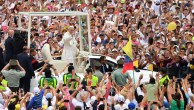A number of questions in the survey speak to how Hispanics view the Catholic Church, its new leader and its teachings. At the time the survey was conducted – just a few months after Pope Francis ascended to the papacy – a majority of Hispanics, including Hispanic Catholics, held a favorable view of him overall, and a plurality considered his election as pope to represent a major change for the Catholic Church. Foreign-born Catholics and those who attend Mass more regularly were particularly favorable in their opinions of the pope, and both groups were especially likely to see the selection of Pope Francis as a major change for the Catholic Church.
However, Hispanics who were raised Catholic but have switched faiths were less positive in their views of Francis and less likely to say he represents a major change for the church. Childhood Catholics who have switched faiths also were less likely to view the Catholic Mass as lively and exciting.
There is a strong consensus among Hispanics, including Hispanic Catholics, that the Catholic Church needs to do a lot more to address the sex abuse scandal. Moreover, most Hispanic Catholics are at odds with the church’s teachings on divorce and contraception, and most favor allowing priests to marry and women to become priests. Disagreement with these church teachings is stronger among those who attend Mass less regularly, but even among weekly Mass attenders, roughly half or more support changing the church’s positions on these issues.
The survey also finds that there has been a slight uptick in recent years in the number of Catholics who say they “could imagine leaving the Catholic Church someday.” Among Catholic adults under age 30, nearly four-in-ten now express this view.
Trends reported in this chapter come from the 2006 Pew Research Center survey of Hispanics and religion and a subsequent call-back survey of Hispanic Catholics conducted in 2007. See Appendix A: Survey Methodology for more detail.
Views of Pope Francis
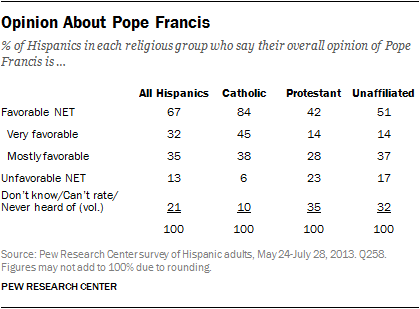
Francis’ election as pope on March 13, 2013, marked the first time a Latin American has been selected as pontiff. Just a few months after Francis became pope – when this survey was conducted – Hispanic Catholics held favorable views of him; fully 84% said their overall opinion of the pope was either “very” favorable (45%) or “mostly” favorable (38%) at that time.18
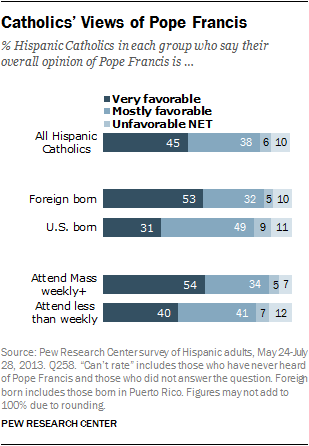
Latino members of other religious groups were far less likely than Catholics to hold any opinion of Pope Francis, but those who did also tended to see him more favorably than unfavorably. Overall, two-thirds (67%) of Hispanics had a favorable opinion of Pope Francis, while just 13% had an unfavorable opinion and about a fifth (21%) did not know enough about the pope to express an opinion.
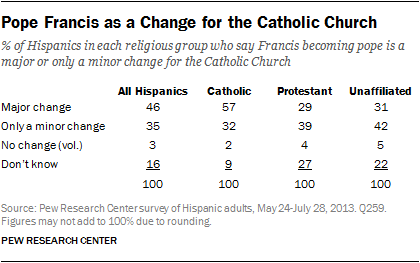
Hispanic Catholics who attend Mass at least once a week tended to have more strongly favorable views of the pope than less frequent attenders, who were slightly less likely to have an opinion about him. And foreign-born Hispanic Catholics were more positive in their views about the pope than were U.S.-born Catholics (53% and 31%, respectively, saw Francis very favorably.)
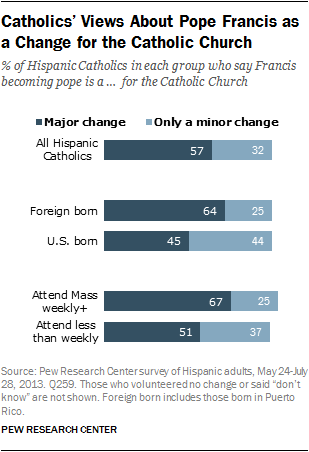
The survey also asked respondents whether the election of Pope Francis represented a major change or only a minor change for the Catholic Church. At the time of the survey, nearly six-in-ten Hispanic Catholics (57%) said the selection of Francis as pope was a major change for the church.19
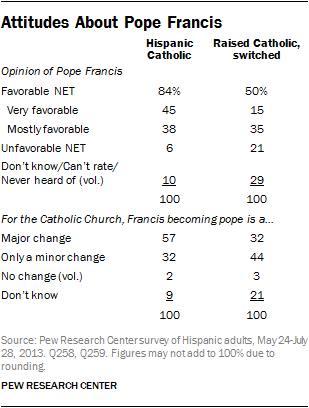
Hispanic Protestants and the religiously unaffiliated were much less inclined than Catholics to see the selection of Pope Francis as a major change for the Catholic Church; both groups were less likely to hold an opinion about this issue, however.
Hispanic Catholics who attend Mass at least once a week were more inclined than those who attend less frequently to see Francis as a major change for the church as of mid-2013 (67% and 51%, respectively). And more foreign-born Catholics than those born in the U.S. saw him as a major change (64% and 45%, respectively).
Hispanics who were raised Catholic and have switched faiths held less favorable views of the pope than Hispanics who are Catholic, and they were less likely to see Francis as a major change for the Catholic Church. Former Catholics also were less inclined than Catholics to express any opinion on these questions.
Addressing the Clergy Sex Abuse Crisis
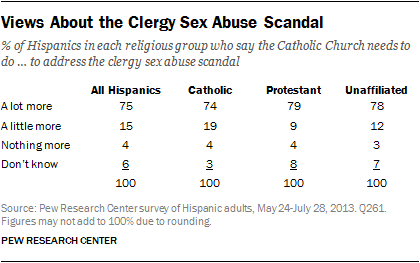
Hispanics agree that the Catholic Church needs to do more to address the clergy sex abuse scandal.20 Three-quarters of all Hispanics say the church needs to do “a lot more” to address the sex abuse scandal, while 15% say it needs to do “a little more” and just 4% say it needs to do nothing more. Opinion on this issue is similar across all religious groups; 74% of Catholics, 78% of the unaffiliated and 79% of Protestants say the Catholic Church needs to do a lot more to address the scandal. Among former Catholics, 82% say the church needs to do a lot more regarding this issue.
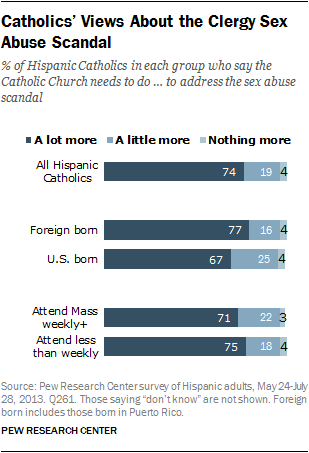
There are no significant differences in opinion about this issue between Hispanic Catholics who attend services more and less frequently. Foreign-born Hispanic Catholics are slightly more likely than their U.S.-born counterparts to say the church needs to do a lot more to address the clergy sex abuse scandal (77% vs. 67%).
Views on Church Teachings
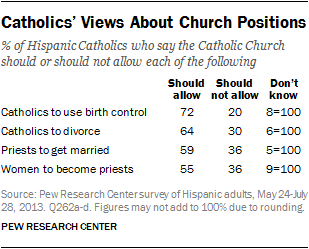
Most Hispanic Catholics support changes to the Catholic Church’s positions on certain issues. About seven-in-ten Hispanic Catholics (72%) think the church should allow its members to use birth control, and about two-thirds (64%) say the church should permit divorce. Majorities of Hispanic Catholics also say the church should allow priests to get married (59%) and allow women to become priests (55%).
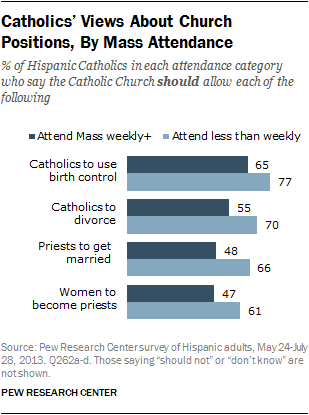
On each of these issues, there is less support for change among Catholics who attend Mass at least once a week than among those who attend less often. But even among Catholics who attend Mass regularly, roughly half or more support some change to church positions on these issues.
These questions were not asked of former Catholics.
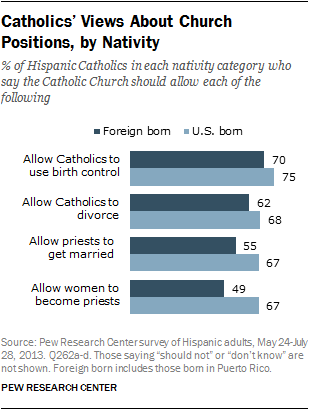
There is also slightly less support for change among foreign-born Hispanic Catholics than among those born in the U.S. About two-thirds or more of U.S.-born Hispanic Catholics support the church changing its position on each of these four issues. Among foreign-born Catholics, about half or more support allowing priests to marry and women to become priests, and solid majorities think the church should allow its members to use birth control and to get divorced.
Hispanic Catholics closely resemble white, non-Hispanic Catholics in their views about birth control; 72% of Hispanic Catholics and 74% of white, non-Hispanic Catholics favor allowing Catholics to use birth control, contrary to the church’s official position.
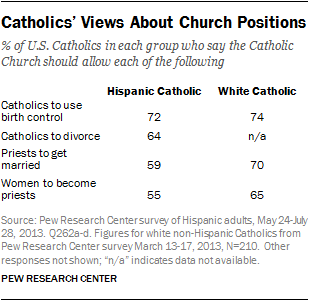
But there are differences between Hispanic and white, non-Hispanic Catholics when it comes to views about changes in the rules for priests. White Catholics are more inclined than Hispanic Catholics to favor allowing priests to marry, though a majority of Hispanic Catholics also favor this proposal (70% and 59%, respectively). Similarly, more white Catholics (65%) than Hispanic Catholics (55%) favor allowing women to become priests.
Views of Catholic Mass
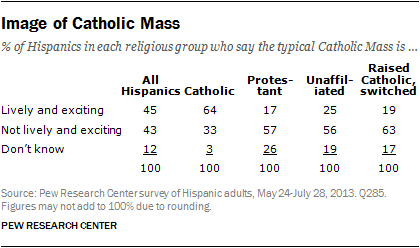
When it comes to views of the Catholic Mass, about two-thirds of Hispanic Catholics (64%) say the typical Mass is lively and exciting, while a third disagree. By contrast, 63% of Hispanics who were raised Catholic but have since switched faiths say they do not consider the Mass to be lively and exciting.
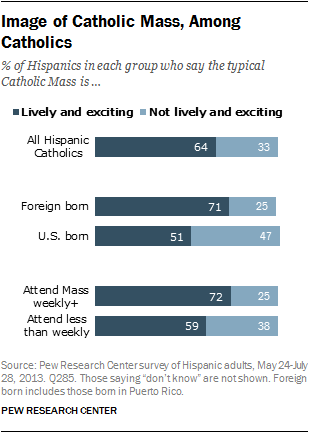
Majorities of Hispanic Protestants and the religiously unaffiliated do not consider the typical Catholic Mass lively and exciting, and about a fifth or more of both groups do not express an opinion about this.
Compared with the 2006 Pew Research survey, fewer Hispanics overall say the typical Mass is lively and exciting (56% in 2006 vs. 45% today). The share of Hispanic Catholics who say the typical Mass is lively and exciting also is down, from 71% in 2006 to 64% today.
Hispanic Catholics who attend Mass at least once a week are more inclined to see the typical service as lively and exciting than those who attend less often (72% vs. 59%). And foreign-born Hispanic Catholics are more likely than the U.S. born to see the typical Mass as lively and exciting (71% vs. 51%).
The Catholic Church and Immigrants
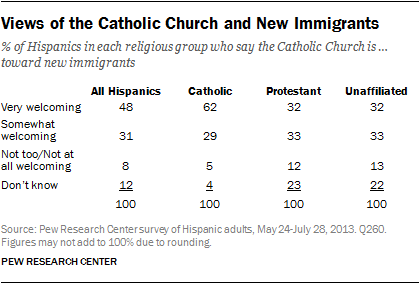
Hispanics tend to see the Catholic Church as welcoming to new immigrants. About half of all Hispanics (48%), including 62% of Hispanic Catholics, consider the Catholic Church “very welcoming” to new immigrants. Hispanic Protestants and the religiously unaffiliated are less inclined to see the Catholic Church as welcoming to new immigrants, although both groups also are less likely to hold an opinion about this issue.
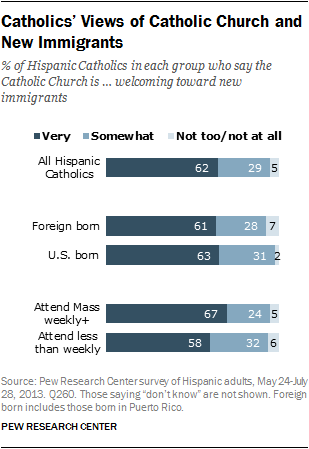
Compared with 2006, fewer Hispanics overall now see the Catholic Church as very welcoming to new immigrants (56% in 2006 vs. 48% today), but the share of Hispanic Catholics who see the church as very welcoming has stayed about the same (60% in 2006 vs. 62% today).
Foreign-born Latino Catholics are as likely as U.S.-born Latino Catholics to see the church as very welcoming to immigrants. And although Latino Catholics who attend Mass at least once a week are a bit more inclined to see the church as very welcoming to immigrants than those who attend Mass less often, majorities of both groups see the church this way.
Strength of Ties to the Catholic Church
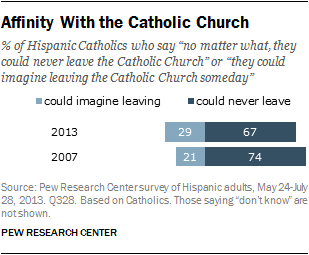
The survey also included an indirect indicator of affinity with the Catholic Church. The survey asked Catholics the following question: “Some people tell us that no matter what, they could never leave the Catholic Church. Others say that they could imagine leaving the Catholic Church someday. Which of these comes closest to your view?” About two-thirds of Latino Catholics say they could never leave the church, and 29% say they could imagine leaving. While still the minority viewpoint, more Catholics today say they could imagine leaving the church than said so in 2007 (21%).
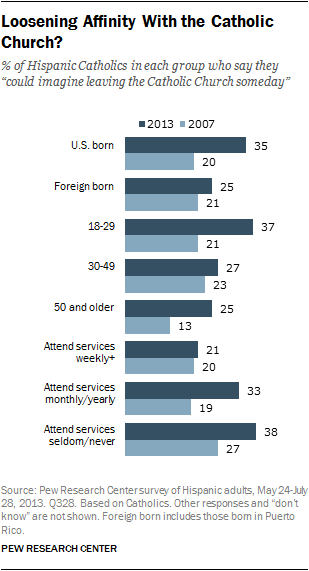
U.S.-born Hispanic Catholics have changed their views on this question more than foreign-born Catholics; fully a third of the native born (35%) say they could imagine leaving the church, up from 20% in 2007. Among age groups, the change is most pronounced among Catholics ages 18-29, 37% of whom say they could imagine leaving the church someday (compared with 21% in 2007). Those who attend Mass less than once a week also have become more likely to say they could imagine leaving the Catholic Church someday.
Are There Vestiges of a Catholic Upbringing?
Do former Catholics who have switched faiths or become religiously unaffiliated maintain some of their Catholic beliefs and resemble current Catholics? On some measures – for example, views of Pope Francis and of the typical Catholic Mass – Hispanics who were raised Catholic but have left the faith differ sharply from current Hispanic Catholics. But on some other measures – for instance, some beliefs and practices related to the Virgin Mary – there is some evidence that childhood Catholics who have switched to Protestantism differ from those who were raised Protestant, suggesting that childhood practices and beliefs persist to some degree. Similarly, a sizable minority of unaffiliated Hispanics who were raised Catholic report behaviors that may reflect their upbringing in the Catholic faith.
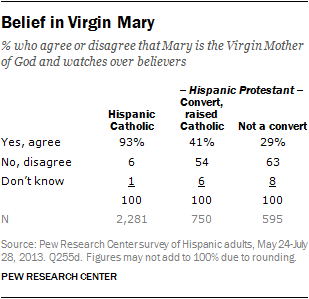
Hispanic Catholics are nearly unanimous in their belief that “Mary is the Virgin Mother of God and watches over believers.” Fully 93% of Hispanic Catholics agree with this statement. Among Hispanic Protestants, belief in the Virgin Mary is much less common; about three-in-ten Hispanic Protestants who were raised Protestant (29%) believe that Mary is the Virgin Mother of God and watches over believers. But a somewhat larger share (41%) of Protestants who converted from Catholicism hold this view.
Roughly eight-in-ten Catholics (81%) say they pray to the Virgin Mary, including 76% of those who attend Mass less than weekly and 88% of those who attend at least once a week. Among Hispanic Protestants, those raised Catholic are more likely than those who did not convert to say they pray to Mary (16% vs. 7%). Among those who were raised Catholic and are now unaffiliated, 27% say they pray to Mary.
The pattern is similar on the question of religious objects in the home. An overwhelming majority of Hispanic Catholics (84%) say they have a crucifix or other religious object in their home, a practice common among Catholics who attend Mass weekly (87%) as well as those who attend less often (83%). A sizable minority of the unaffiliated who were raised Catholic (45%) also say they have a religious object in their home. And among current Protestants who were raised Catholic, 46% have a religious object displayed in their home, compared with 27% of Protestants who are not converts. Childhood Catholics who are now mainline Protestants are more likely to have a religious object in their home than are those who converted to evangelical Protestantism (70% vs. 40%).
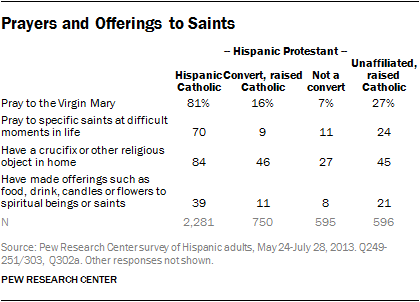
There is little difference between Hispanic Protestants raised as Catholic and lifelong Protestants when it comes to making offerings to saints or spiritual beings. Roughly four-in-ten Hispanic Catholics (39%) say they have made offerings such as food, drink, candles or flowers to saints or spiritual beings, as do about one-in-ten Hispanic Protestants who were raised as Catholic (11%) and Hispanic Protestants who are not converts (8%). Roughly a fifth (21%) of unaffiliated Hispanics who were raised Catholic also say they have made such offerings.




